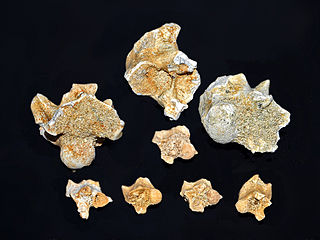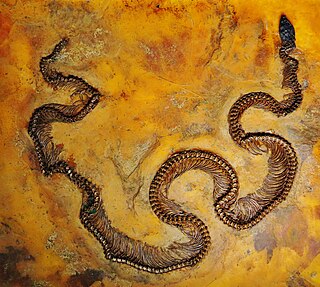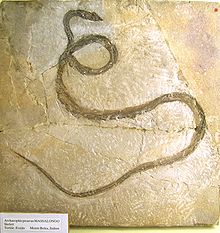
Colubridae is a family of snakes. With 249 genera, it is the largest snake family. The earliest fossil species of the family date back to the Late Eocene epoch, with earlier origins suspected. Colubrid snakes are found on every continent except Antarctica.

Monte Bolca is an Early Eocene-aged geologic site located near Verona, Italy. A Konservat-Lagerstätte, it contains an extremely well-preserved and diverse marine biota, including the most diverse fish fauna of any Cenozoic fossil site, as well as many of the earliest fossil occurrences of modern marine fish groups. It was one of the first fossil sites with high quality preservation known to Europeans, with studies of its biota dating back to the 18th century and earlier, and is still an important source of fossils.

Basilosauridae is a family of extinct cetaceans. They lived during the middle to the early late Eocene and are known from all continents, including Antarctica. They were probably the first fully aquatic cetaceans. The group is noted to be a paraphyletic assemblage of stem group whales from which the monophyletic Neoceti are derived.

The Gempylidae are a family of scombriform ray-finned fishes commonly known as snake mackerels or escolars. The family includes about 25 species.

Palaeophis is an extinct genus of marine snake that is the type genus of the extinct snake family Palaeophiidae.

Kutchicetus is an extinct genus of early whale of the family Remingtonocetidae that lived during Early-Middle Eocene in what is now the coastal border of Pakistan and India. It is closely related to Andrewsiphius with which it was synonymized by Gingerich et al. 2001. Thewissen & Bajpai 2009 proposed a new clade, Andrewsiphiinae, for the two species. Later authors, however, still accept both as separate genera.

Justitia is a genus of spiny lobsters. Following the recognition of Nupalirus as a separate genus, Justitia comprises one extant species and two fossil species:

Acherontemys is an extinct genus of turtle from Eocene sediments in northwestern North America and comprising a single species Acherontemys heckmani. Acherontemys has been placed within the pond turtle superfamily Testudinoidea as part of the clade Pan-Emydidae.

Eoaulostomus is an extinct genus of marine ray-finned fish, closely related to the modern trumpetfish, that lived during the Eocene. It contains two species, E. bolcensis(de Blainville, 1818) and E. gracilisBlot, 1981, both known from the Early Eocene-aged Monte Bolca site of Italy.

Palaeopython is an extinct genus of snake from the Eocene of Europe. The genus has been used to refer to large Western and Central European snake vertebrae from the Eocene. P. cadurcensis and the tentatively-referred "P." neglectus originate from France; P. ceciliensis originates from Germany; and P. helveticus originates from Switzerland. A species known from multiple well-preserved specimens found in the Messel Pit of Germany, P. fischeri, was named by Stephan Schaal in 2004, but examination of the genus showed that it represented a distinct lineage; it was renamed Eoconstrictor fischeri in 2020 by Agustín Scanferla and Krister T. Smith. Another species from France, P. filholii, was moved to the genus Phosphoroboa in 2021 by Georgalis, Márton Rabi, and Smith. An additional species, P. sardus, was described in 1901 by Alessandro Portis from the Middle Miocene of Monte Albu. However, a reevaluation of the holotype specimen of this species revealed it to actually belong to an indeterminate acanthomorph fish. A new species, P. schaali, based on two complete skeletons from the Eocene of Messel, Germany, was described in 2022 by Smith and Scanferla..
Listrognathosuchus is an extinct genus of alligatoroid crocodilian. Fossils date back to the middle Paleocene epoch. In 1997, the generic name replaced that of Leidyosuchus for the species L. multidentatus. "L." multidentalis was first described by Charles Mook in 1930 on the basis of the holotype AMNH 5179, consisting of a partial vertebral column, mandible, partial left ilium, and left tibia, found from a locality in Torrejon Arroyo, New Mexico.

Scyllarides is a genus of slipper lobsters.

The Platyrhinidae are a family of rays, commonly known as thornbacks due to their dorsal rows of large thorns. They resemble guitarfishes in shape. Though traditionally classified with stingrays, molecular evidence suggests they are more closely related to electric rays in the order Torpediniformes.

Trionyx is a genus of softshell turtles belonging to the family Trionychidae. In the past many species in the family were classified in this genus, but today T. triunguis, the African or Nile softshell turtle, is the only extant softshell still classified as Trionyx. The other species still assigned to this genus are only known from fossils. T. triunguis is a relatively large, aquatic piscivore.
Ototriton is an extinct genus of rhineurid amphisbaenian or worm lizard from the Early Eocene of the western United States, including the type and only species Ototriton solidus. Paleontologist F. B. Loomis named Ototriton in 1919 on the basis of a single skull from the Wind River Formation in Wyoming, misinterpreting it as the skull of a salamander. Unlike salamanders and like other rhineurids, Ototriton has a shovel-shaped snout that it presumably used for burrowing underground. Ototriton is one of the earliest known rhineurids and also one of the largest.

Palaeophiidae is an extinct family of marine snake within the infraorder Alethinophidia.

Eoconstrictor is an extinct genus of booid snake, which supposedly had infrared vision, from the Eocene of Germany. The type species, E. fischeri is known from multiple well-preserved specimens found in the Messel Pit of Germany. It was originally named as Palaeopython fischeri by Stephan Schaal in 2004, but examination of the genus showed that it represented a distinct lineage; it was renamed as the new genus Eoconstrictor in 2020. In a subsequent study Georgalis, Rabi & Smith (2021) reinterpreted "Paleryx" spinifer from the Eocene Geiseltal Lagerstätte as the second species belonging to the genus Eoconstrictor. Palci et al. (2023) named the third species belonging to this genus, E. barnesi described on the basis of fossils from the Geiseltal Lagerstätte.

Eogaleus is an extinct genus of requiem shark from the Eocene epoch. It contains a single species, E. bolcensis. It is known from multiple articulated individuals from the Bolca Konservat−Lagerstätte of the Ypresian of Italy. It was a shallow water species.

Vasuki is an extinct genus of madtsoiid snake from the Middle Eocene Naredi Formation of India. The genus contains a single species, V. indicus, known from several vertebrae. Vasuki has an estimated body length between 10.9–15.2 m (36–50 ft), making it the largest known madtsoiid. The upper bounds of the length estimates would make Vasuki the longest snake ever discovered.
The Eocene-aged Monte Bolca fossil site near Verona, Italy was one of the first lagerstatte to be discovered to science, and still has one of the most prominent vertebrate faunas of all Cenozoic lagerstatte. It has the highest fish diversity of all known Cenozoic fossil sites, with many fossils having extremely detailed preservation. In addition, a very high diversity of marine invertebrates & land plants and a small number of land vertebrates are also known.
















